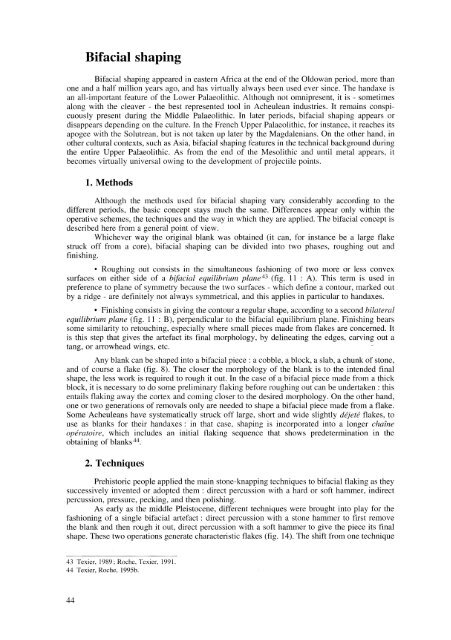Technology and Terminology of Knapped Stone - IRIT
Technology and Terminology of Knapped Stone - IRIT
Technology and Terminology of Knapped Stone - IRIT
You also want an ePaper? Increase the reach of your titles
YUMPU automatically turns print PDFs into web optimized ePapers that Google loves.
Bifacial shapin g<br />
Bifacial shaping appeared in eastern Africa at the end <strong>of</strong> the Oldowan period, more than<br />
one <strong>and</strong> a half million years ago, <strong>and</strong> has virtually always been used ever since. The h<strong>and</strong>axe is<br />
an all-important feature <strong>of</strong> the Lower Palaeolithic. Although not omnipresent, it is - sometimes<br />
along with the cleaver - the best represented tool in Acheulean industries. It remains conspicuously<br />
present during the Middle Palaeolithic. In later periods, bifacial shaping appears or<br />
disappears depending on the culture. In the French Upper Palaeolithic, for instance, it reaches its<br />
apogee with the Solutrean, but is not taken up later by the Magdalenians. On the other h<strong>and</strong>, in<br />
other cultural contexts, such as Asia, bifacial shaping features in the technical background during<br />
the entire Upper Palaeolithic. As from the end <strong>of</strong> the Mesolithic <strong>and</strong> until metal appears, it<br />
becomes virtually universal owing to the development <strong>of</strong> projectile points.<br />
1. Methods<br />
Although the methods used for bifacial shaping vary considerably according to the<br />
different periods, the basic concept stays much the same. Differences appear only within the<br />
operative schemes, the techniques <strong>and</strong> the way in which they are applied. The bifacial concept is<br />
described here from a general point <strong>of</strong> view.<br />
Whichever way the original blank was obtained (it can, for instance be a large flake<br />
struck <strong>of</strong>f from a core), bifacial shaping can be divided into two phases, roughing out <strong>and</strong><br />
finishing.<br />
• Roughing out consists in the simultaneous fashioning <strong>of</strong> two more or less convex<br />
43<br />
surfaces on either side <strong>of</strong> a bifacial equilibrium plane (fig. 11 : A). This term is used in<br />
preference to plane <strong>of</strong> symmetry because the two surfaces - which define a contour, marked out<br />
by a ridge - are definitely not always symmetrical, <strong>and</strong> this applies in particular to h<strong>and</strong>axes.<br />
• Finishing consists in giving the contour a regular shape, according to a second bilateral<br />
equilibrium plane (fig. 11 : B), perpendicular to the bifacial equilibrium plane. Finishing bears<br />
some similarity to retouching, especially where small pieces made from flakes are concerned. It<br />
is this step that gives the artefact its final morphology, by delineating the edges, carving out a<br />
tang, or arrowhead wings, etc.<br />
Any blank can be shaped into a bifacial piece : a cobble, a block, a slab, a chunk <strong>of</strong> stone,<br />
<strong>and</strong> <strong>of</strong> course a flake (fig. 8). The closer the morphology <strong>of</strong> the blank is to the intended final<br />
shape, the less work is required to rough it out. In the case <strong>of</strong> a bifacial piece made from a thick<br />
block, it is necessary to do some preliminary flaking before roughing out can be undertaken : this<br />
entails flaking away the cortex <strong>and</strong> coming closer to the desired morphology. On the other h<strong>and</strong>,<br />
one or two generations <strong>of</strong> removals only are needed to shape a bifacial piece made from a flake.<br />
Some Acheuleans have systematically struck <strong>of</strong>f large, short <strong>and</strong> wide slightly déjeté flakes, to<br />
use as blanks for their h<strong>and</strong>axes : in that case, shaping is incorporated into a longer chaîne<br />
opératoire, which includes an initial flaking sequence that shows predetermination in the<br />
obtaining <strong>of</strong> blanks 44<br />
.<br />
2. Technique s<br />
Prehistoric people applied the main stone-knapping techniques to bifacial flaking as they<br />
successively invented or adopted them : direct percussion with a hard or s<strong>of</strong>t hammer, indirect<br />
percussion, pressure, pecking, <strong>and</strong> then polishing.<br />
As early as the middle Pleistocene, different techniques were brought into play for the<br />
fashioning <strong>of</strong> a single bifacial artefact : direct percussion with a stone hammer to first remove<br />
the blank <strong>and</strong> then rough it out, direct percussion with a s<strong>of</strong>t hammer to give the piece its final<br />
shape. These two operations generate characteristic flakes (fig. 14). The shift from one technique<br />
43 Texier, 1989; Roche, Texier, 1991.<br />
44 Texier, Roche, 1995b.<br />
44

















